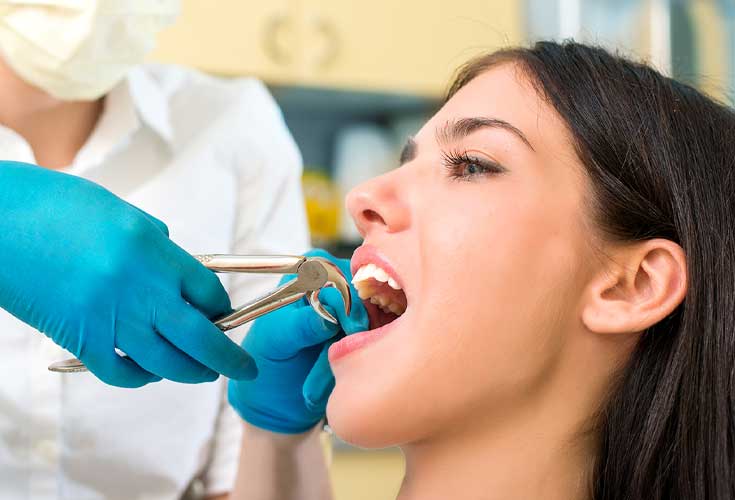Tooth Extraction
Tooth Removal
At Rochedale Central Dentist, we always try to fix a tooth has been broken or damaged by decay. However, in some cases when there’s too much damage for the tooth to be repaired, then the dentist opts for tooth extraction.

Types of Extractions
Your tooth extraction will depend on whether your tooth is visible or impacted. There are two types of extractions:
A simple extraction – The dentist uses an instrument called an elevator to loosen the tooth. Then a forceps is used to remove the tooth.
A surgical extraction – In this procedure, the oral surgeon will make an incision into your gum to surgically remove the broken tooth or impacted wisdom tooth.
Medical Causes of Tooth Extraction
Although permanent teeth are meant to survive for a lifetime, sometimes your dentist will recommend tooth extraction due to the following reasons:

If you are undergoing procedures such as chemotherapy, organ transplant or bone marrow treatment that impact your immune system, then the risk of infection is much higher. Hence, the dentist recommends extraction of vulnerable teeth.
Dental Infection
Sometimes the dentist will choose tooth extraction if tooth decay extends to the gum and pulp. The dentist will try use the root canal procedure and If the infection is too severe, then the tooth has to be removed. Remember, the dentist will always try to save the tooth.


This is probably the most common reason for teeth extraction. People who don’t visit dentist regularly are more prone tooth decay beyond repair. This because there are no symptoms during the early stages. Other reason is damage to the tooth is being knocked off due to an accident. The patient may suffer significant trauma necessitating removal of tooth.
Crowded Teeth
Some people have extra teeth that block other teeth and for some children baby teeth don’t fall out in time and blocks the permanent teeth to come in. People getting braces may need space for the teeth that are being moved into place. This is often the case when dentist prepare the mouth for orthodontics (process of properly aligning teeth).


A tooth infection can be serious and can even lead to fatality when delicate heart procedures like heart transplant, damaged valves and repair of congenital heart defects are performed. In such cases, the dentists in consultation with the cardiologist, remove any tooth that are prone to severe infection.
Gum Disease
Severe gum disease can cause the loosening of the tissues and bones around the tooth. This eventually leads to tooth becoming loose. Chewing food becomes hard and often kills the sensation on the tooth. The dentist might recommend extraction depending on the extent of the disease.

Immune System Disorders
You will have to notify the dentist about any pre-existing immune system problems such as genetic immune disorders or immune problems caused by a previous ailment. If you’ve had an organ failure or organ transplants, then you will have to inform your dentist. That’s because tooth infection could further aggravate the existing organ problems in the body. Always inform your dentist any current illness or medication that you could be taking.
The Process of Tooth Extraction
The tooth removal is usually a 4-step process that usually lasts for 30 to 90 minutes. The patient usually does not feel any pain but only the pressure of extraction.
Application of Anaesthesia
Before the tooth is extracted, local anaesthesia is injected to make the tooth and the area around it numb. If extraction involves more than one tooth or if the damage is extreme, then the dentist may resort to general anaesthesia.
Teeth Removal
Once the tooth and surrounding areas becomes numb, the dentist will loosen it. Occasionally, the dentist might have to cut away bone tissue and gum to extract the tooth. The dentist will then use forceps to remove the tooth.
Surgical Treatment after Extraction
Dentist uses a gauze pad to stop the bleeding and the gap in the tooth is filled with a blood clot. If the extraction involves cuts, the dentist will put a few self-dissolving stitches as a remedy.
Post-Extraction Care
Once the blood clots, the socket will begin to heal naturally. However, sometimes the blood clot can break and lead to a condition is known as dry socket. The dentist usually applies a sedative dressing over the socket. Once a new blood clot forms, the process of healing resumes naturally.
Healing and Recovery
It normally takes a few days to recover after a tooth extraction. Things to keep in mind as you recover:
Immediately after extraction
1. Keep biting at the gauze pad till a clot forms at the socket.
2. Apply ice cubes on the extracted area to prevent swelling.
3. Make sure you take the medications as recommended by the dentist.
For the Next 48 Hours
1. Avoid using force while rinsing your mouth to avoid dislodging the clot.
2. Rinse your mouth with warm water mixed salt.
3. Do not drink from a straw and avoid sucking anything from a bottle or cup.
Dietary Choices
1. Avoid smoking
2. Eat soft foods and drinks such as soup, and yoghurt.
3. Introduce solid foods back into your diet after 24 hours.
4. Avoid brushing upon the extraction area till it fully heals.
Post-Extraction Risks
You could encounter risks such as persistent bleeding, infection, swelling and discharge after tooth extraction. In such cases, get in touch with your dentist immediately.
We Bulk Bill
We bulk-bill HICAPS, Kids eligible under child dental benefit scheme (CDBS), Veteran Affairs (DVA Gold Card), Emergency and General dental vouchers from QLD Government (Oral Health Services).
- HICAPS - for fast claims on the spot
- Veteran Affairs (DVA Gold Card) bulk billing options available
- Eligible kids are bulk-billed under Child Dental Benefit Scheme
- We accept general dental vouchers from QLD Government








